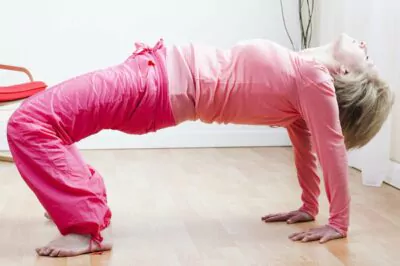I am writing this in Connecticut right now, (Kevin and I just moved back east) and we are preparing for another snow storm! We haven’t experienced a winter like this in years and we are loving every minute of it!
I think we have truly missed the change of seasons. Our friends here and in Cali think we are a bit crazy, but now that we have had our taste of winter (and more to come this week) Spring will be that much more inviting, that much more pleasant. Those wonderful fragrances, that oh so lovely breeze, and all the precious new life. Having something to look forward to can be just as good for your wellbeing as a fitness routine. Spring we are excited for your arrival!
With spring brings change, so if you have not started a new workout routine now is the perfect time! We are here to help!
You can stay calm. We’re not going to tell you to do forty squats a day until your thighs could snap steel. (Though I might in an actual bootcamp class.) Instead, I’m sharing one of my favorite movement sequences, whose long-term benefits go far beyond looking good for bikini season, improving your body and mind from the inside out. It’s what one practitioner described as the rod of iron inside me, around which the chaos of life revolves. It is an ancient Eastern sequence called the Five Tibetan Rites.
The Five Tibetan Rites
The Five Tibetan Rites are a series of movements that were developed by early Tibetan lamas, or Buddhist monks, that aimed to harness the power of the body’s seven vortexes, or centers, to promote healing, virility, and longevity. When brought to the attention of the Western world in the 1940s, these “deceptively simple but very powerful” movements were dubbed as being a metaphorical Fountain of Youth, so impressed was the world with the vigor and strength—both spiritually and physically—of the elderly monks.
The origin story of the Five Tibetan Rites was never well-documented by the Tibetan people, so our history of the tradition begins with the publication of The Eye of Revelation, by Peter Kelder, in 1936. Kelder, as he tells in his book, met a middle-aged British colonel who relayed to him the mesmerizing power of the Rites he’d encountered in a remote part of Tibet. Later, after years of separation, Kelder met the colonel again but nearly didn’t recognize the man, so great had his youthful transformation been. The cause? The colonel gave all the credit to the monks, who had taught him to perform the Rites dutifully until his stooped back became straight and his hair, miraculously, returned to its boyish color. Kelder was so enthralled that he proceeded to tell the tale, explaining in detailed illustration the five movements of the Rites, in a short book.
While your hair might not revert to the color it was when you were a child, the benefits of performing the Rites today are well-advocated for. In fact, although there is only one remaining copy of Kelder’s booklet, the practice of the Five Tibetan Rites continues to be carried out all over the western world by those who want to improve their physical health and emotional and mental wellbeing.
Improved awareness of and connection with your body, reduced stress levels, better sleep, and an overall sense of calm and balance are some of the psychological benefits attributed to practicing the Rites. Physically, the movements are said to increase flexibility, build strong back and core muscles, improve coordination, and boost your energy levels.
It’s an easy, daily workout that wellness obsessives like the ASC team can get behind 100%. And, the best place to do it? Outdoors, when the temperature is neither too hot nor cold and the sun not too burning. Spring.
Must-Read Tips and Cautions Before Starting
1—Go slow. There’s a risk of dangerous compression of back and neck muscles if done too fast or improperly, so, especially when first starting out, go much slower than you think you need to. (You might even want to consider doing your first sequence with a professional!)
2—Never strain. If something pinches or hurts, ease up immediately. The Rites are meant to be built up to, so no need to do everything perfectly at once.
3—Be comfortable. Wear loose-fitting clothing that doesn’t restrict movement and allows your body to breathe. And be barefoot. Come prepared with a thick yoga mat (bonus points if it’s made from a natural fiber like cotton or hemp—the ancient Tibetans used thick wool prayer rugs).
4—Don’t try to follow the 1936 instructions. Read Kelder’s The Eye of Revelation if you want to understand the entertaining story behind the Rites, but don’t use it as a manual for practice, because it doesn’t address certain health risks. (Pssst, the short work is in the public domain, so it can be downloaded for free.)
5—Remember to breathe. Though the original booklet made no mention of any breathing techniques, many practitioners have since suggested rhythmic breathing to make the movements more effective or easier. Check out mindbodygreen’s breathing tips for each Rite, here. Kelder’s book suggested standing tall with your hands on your hips for deep breathing between each Rite.
6—Go gradually. The goal is to be able to do twenty-one reps of each Rite, every day. But most people start with just three and work their way up gradually.
The Five Tibetan Rites
1—Spin Like a Child
Stand tall, with your arms horizontally above the floor in line with your shoulders and your feet comfortably apart. Spin around clockwise slowly, until slightly dizzy. Focus on something to orient yourself as you spin and count your rotations. Although the goal is to get to twenty-one spins, most people get dizzy far before that—you should stop when you feel yourself getting dizzy.
2—V-up
Lie on your back on, arms to your sides and palms down on the floor. Keep your legs straight and feet flexed with your big toes touching and lift your legs over your head (if possible) while lifting your head off the ground, pulling your chin toward your chest. Then, slowly lower your legs and head simultaneously. Relax. Repeat until it feels too difficult, up to twenty-one times. You may also modify this one by bending your knees.
3—Back Bend
Kneel on your mat and place your hands on the backs of your thighs. Crawl your hands as far down your legs as they can go, pulling your shoulders down and back and lifting your head toward the ceiling. Then, lean your head back as far as feels comfortable, and lean your body backward, arching your back. Remember to support your back by engaging your core. If you feel yourself getting dizzy, don’t drop your head so far. Repeat up to twenty-one times.
4—I like to call this one the “Table Maker.”
Sit on your mat with your legs stretched out straight twelve inches apart and your palms on the floor directly below your shoulders. Then, while dropping your head gently back, push your body up to be completely straight, like a table. Your knees should be bent at right angles, and your arms should be straight. Tense all your muscles to keep still for a moment, then come back to a sitting position. Repeat up to twenty-one times.
5—Downward dog into upward dog.
Lie on your stomach. Place hands on the mat beside you, about shoulder-width apart, with your legs stretched out, two feet apart, behind you. Push up into downward facing dog. Your hips should be the focus; lift them up and back to extend your spine and put your head against your chest. Then, lower yourself into upward-facing dog, lifting your chest toward the ceiling and pulling your shoulders back, while keeping arms straight. Repeat up to twenty-one times.
A little throwback for all you… Here is a link to a PDF I put together years ago, but the information is timeless. The images on this PDF will make this routine that much easier to follow along (check out page 162 for photos of each Rite!)
Much Love,
Annmarie Gianni
References and Further Reading:
Kelder, P. & Carolinda Witt (2014). The Five Tibetan Rites: Ancient Anti-Aging Secrets of the Five Tibetan Rites. Australia: UnMind Pty Ltd.
https://www.mindbodygreen.com/0-17551/fountain-of-youth-5-tibetan-exercises-you-should-be-doing-every-day.html
https://www.doyouyoga.com/the-5-tibetan-rites-yoga-like-a-tibetan-monk/







